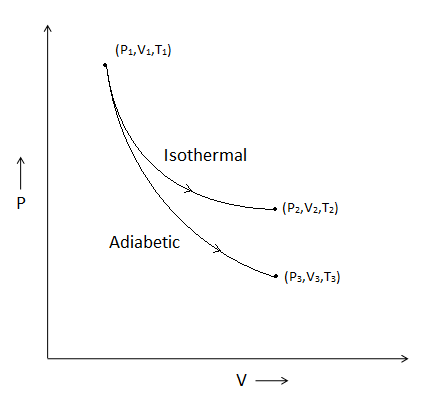
The reversible expansion of an ideal gas under adiabatic and isothermal conditions is shown in the figure. Which of the following statement(s) is(are) correct?

[This question has multiple correct options]
(A)
(B)
(C)
(D)

Answer
489.6k+ views
3 likes
Hint: Isothermal process is a process in which the temperature remains the same throughout the process. So,
Complete answer:
We will find which of the statements are wrong as given in the graph.
- Isothermal process is a process in which the temperature remains the same throughout the process. In the isothermal curve, we can see that the initial temperature is
- In adiabatic processes, the heat of the system remains constant. So, in this process, we can say that the initial temperature is shown as
- In the isothermal process, we know that
- We have seen earlier that the change in internal energy in isothermal energy is zero. Thus,
Thus, we can conclude that options (A), (C) and (D) are correct.
Note:
Remember that a process can be called reversible if the change is brought in such a way that it can be reversed by a change. It involves equilibrium states in it. The processes that are not reversible are called irreversible processes.
Complete answer:
We will find which of the statements are wrong as given in the graph.
- Isothermal process is a process in which the temperature remains the same throughout the process. In the isothermal curve, we can see that the initial temperature is
- In adiabatic processes, the heat of the system remains constant. So, in this process, we can say that the initial temperature is shown as
- In the isothermal process, we know that
- We have seen earlier that the change in internal energy in isothermal energy is zero. Thus,
Thus, we can conclude that options (A), (C) and (D) are correct.
Note:
Remember that a process can be called reversible if the change is brought in such a way that it can be reversed by a change. It involves equilibrium states in it. The processes that are not reversible are called irreversible processes.
Recently Updated Pages
Master Class 11 Economics: Engaging Questions & Answers for Success

Master Class 11 Business Studies: Engaging Questions & Answers for Success

Master Class 11 Accountancy: Engaging Questions & Answers for Success

Master Class 11 English: Engaging Questions & Answers for Success

Master Class 11 Computer Science: Engaging Questions & Answers for Success

Master Class 11 Maths: Engaging Questions & Answers for Success

Trending doubts
State and prove Bernoullis theorem class 11 physics CBSE

1 ton equals to A 100 kg B 1000 kg C 10 kg D 10000 class 11 physics CBSE

State the laws of reflection of light

One Metric ton is equal to kg A 10000 B 1000 C 100 class 11 physics CBSE

Difference Between Prokaryotic Cells and Eukaryotic Cells

1 Quintal is equal to a 110 kg b 10 kg c 100kg d 1000 class 11 physics CBSE




